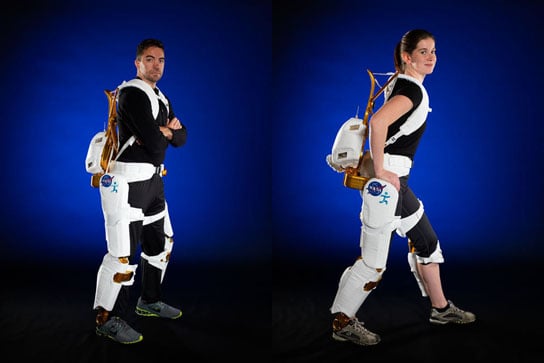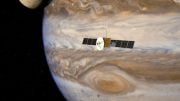
Project Engineers Roger Rovekamp and Shelley Rea demonstrate the X1 Robotic Exoskeleton for resistive exercise, rehabilitation, and mobility augmentation in the Advanced Robotics Development Lab. Credit: Robert Markowitz
A powered exoskeleton might help astronauts accomplish superhuman tasks in orbit. NASA’s new X1 robotic exoskeleton is a direct spinoff their space-borne Robonaut 2 project, and could help astronauts stay healthy while also allowing paraplegics to walk on Earth.
NASA and the Florida Institute for Human and Machine Cognition (IHMC) of Pensacola, Florida, as well as engineers from Oceaneering Space Systems of Houston, have jointly developed the X1. It’s a 57–pound device that humans can wear over their body to assist or inhibit movement in leg joints.
The inhibition mode allows astronauts to use the device as a space-based exercise machine, supplying resistance against leg movement. However, the same technology can be used in reverse on the ground, potentially helping individuals walk for the first time.
The X1 could also become critical for the human exploration of deep space. The harness reaches to the back and shoulders, while the exoskeleton is worn over the legs. The X1 has 10 degrees of freedom, four motorized joints at the hips and knees, and six passive joints allowing for sidestepping, turning, pointing and flexing. The many joint adjustments allow the X1 to be used in a variety of different ways.
The X1 is currently in the R&D phase, focused on design, evaluation, and improvement of the existing technology. The X1 could replace common crew exercises, which are vital to keeping astronauts healthy in microgravity environments. It also has the ability to measure, record, and stream back data to flight controllers on Earth, allowing doctors to get better feedback on the crew’s exercise regimen.
In the future, X1 could provide a robotic power boost to astronauts as they work on the surface of distant planetary bodies. If coupled with a spacesuit, X1 could provide additional force when needed during surface exploration, improving the ability to walk in a reduced-gravity environment.









In my opinion, a full-body muscle stimulator device should be incorporated into the exoskeleton that is made of microfiber nanoelectrodes that can pulsate on cells, nerves, and muscles to stimulate muscle growth and help with the retention of muscles to eliminate muscle loss in space so human missions can last longer. This can be made with exercise equipment that also helps with maintaining more natural body movements and a more comfortable spaceflight experience so astronauts do not come back to earth with weaker bone density and muscle loss. The device can be connected to the space station and be used in intervals when needed or worn constantly in long space flight missions to increase endurance. The technological advancements with this cryptosuit are unlimited if you use it similar to the ones on earth in microgravity or in the far reaches of the universe in deep space missions.